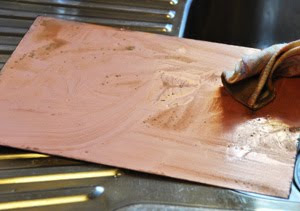I'm Niki, one of your new blog contributors. I work primarily in etchings and am based in sunny Sydney, Australia. I'll hopefully be writing some tutorials and posting international printmaking related competitions which you can be part of. I most definitely don't know everything or even half of it, so if anyone has a tutorial to share, please do share it!
The studio I print at has taught me some 'safer' techniques which generally replace the more harmful chemicals with common household alternatives. The upside of this, aside from the obvious health and safety benefits, is that I can now do a lot of my printmaking at home, therefore paying less studio hire (and travel) fees. Being printmakers, you probably know all the steps already, but what I hope to add are alternative methods for you to try. So with that in mind here is the easy first step:
How to degrease your plate
without ammonia and whiting.
Degreasing your etching plate is important when applying a ground, aquatint, or sugarlift because it allows the medium to stick to the plate. This is traditionally done with ammonia and whiting.
If you don't like the smell of ammonia (it is like rotten fish), what works equally well is household grade powder cleanser like Ajax and soy sauce. You can actually use powder cleanser by itself, but it takes a lot more wiping effort.

You apply it in the same way. Add powder, add soy sauce, and wipe with a clean, grease free rag. Rinse with water.

You'll know when your plate is degreased because the water should stick to the entire plate instead of blobbing up.

The end!
10 comments:
This is a great technique which I use myself! Non-toxic and still leaves the copper clean as a whistle. Thanks for spreading the knowledge!
I'm in college studying Printmaking in Limerick in Ireland and we use zinc plates for etchings. I believe it is a cheaper alternative to copper and that is why we work with it, but we use methylated spirits and whiting to degrease..... I wonder would the soy sauce work the same??
Love the blog! =)
Hey Lilly Bob, it should work with any plate, and if you're using methylated spirits then this is definitely a better alternative.
Zinc here is almost the same price as copper. If you wanted something only 1/10th of the price though, you could use aluminium ;)
What are you using to etch zinc?
We do use aluminium, but for dry points....we etch the zinc with copper sulphate.
I'll definitely mention the soy sauce alternative to our technician! =)
Ahh right. The reason I don't use zinc is that I haven't perfected the copper sulphate recipe yet. With copper, i just use ferric chloride which comes ready-to-use.
Perhaps you could also ask your technician how you guys make the copper sulphate? i was going to post my recipe for it on here as a tutorial but it'd be good to see how other people make it first.
Hey Niki sorry it took me so long to get back to you. I havn't been able to get in touch with our technician since we finished for the summer so i don't know for certain what he uses. I've just posted a documentary I made about him for a college project though if you'd like a look-see into our workshop and his view on printmaking =)
http://lillybob.blogspot.com/2011/06/youre-doing-it-wrong.html
("you're doing it wrong" is his catchphrase for when he catches us making mistakes! )
1 kg copper sulphate
1 kg salt
10l hot water
5l warm water.
=)
awesome!! thanks! (havent seen the link yet, but will add it to my to do list)
For home etching system setup I highly recommend ZAcryl out of Oakland in California. Mark Zaffron, the owner, is very accesible.
zacryl.com
I highly recommend checking out zacryl.com to furnish your own home etching systems. They're my neighbors in Oakland (I'm in LA). Very easy to contact and consult.
zacryl.com
Post a Comment